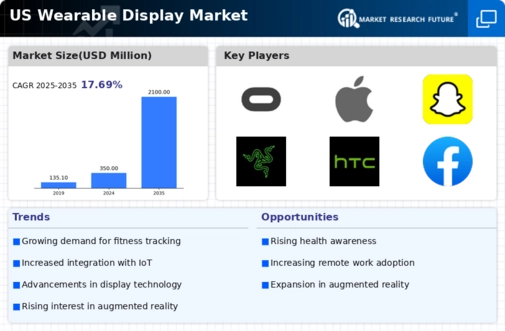Advancements in Display Technology
The wearable display-device-materials market is experiencing a surge due to rapid advancements in display technologies. Innovations such as OLED and microLED are enhancing the visual quality and energy efficiency of wearable devices. These technologies allow for thinner, lighter, and more flexible displays, which are crucial for user comfort and device functionality. According to recent data, the market for OLED materials is projected to grow at a CAGR of 15% through 2026, indicating a robust demand for high-quality display materials. As manufacturers continue to invest in research and development, the integration of these advanced materials into wearable devices is likely to drive market growth significantly.
Expansion of Augmented Reality Applications
the wearable display-device-materials market will benefit from the expansion of augmented reality (AR) applications across various sectors.. Industries such as gaming, education, and healthcare are increasingly adopting AR technologies, which require high-quality display materials for optimal performance. The demand for AR glasses and headsets is projected to grow significantly, with estimates suggesting a market size of $100 billion by 2027. This growth necessitates the development of lightweight and durable display materials that can withstand daily use while providing immersive experiences. As AR technology continues to evolve, the materials used in these devices will play a crucial role in shaping the market landscape.
Growing Investment in Research and Development
Investment in research and development within the wearable display-device-materials market is a critical driver of innovation and growth. Companies are allocating substantial resources to explore new materials and technologies that enhance the performance and functionality of wearable devices. This focus on R&D is expected to yield breakthroughs in areas such as flexible displays, energy-efficient materials, and advanced coatings. As a result, the market is projected to see a compound annual growth rate of 12% over the next five years. The continuous evolution of materials will not only improve product offerings but also attract new players to the market, fostering a competitive landscape.
Increased Consumer Demand for Health Monitoring
The growing consumer interest in health and fitness tracking is a key driver for the wearable display-device-materials market. As individuals become more health-conscious, the demand for devices that monitor vital signs, physical activity, and overall wellness is on the rise. This trend is reflected in the market, where wearable health devices are expected to account for over 40% of total wearable technology sales by 2026. The incorporation of advanced display materials enhances the user experience, providing clear and real-time data visualization. Consequently, manufacturers are focusing on developing materials that support these functionalities, thereby propelling the market forward.
Rising Adoption of Wearable Technology in Enterprises
The adoption of wearable technology in enterprise settings is emerging as a significant driver for the wearable display-device-materials market. Companies are increasingly utilizing wearables for training, safety, and productivity enhancement. For instance, smart glasses equipped with displays are being used in manufacturing and logistics to provide real-time information to workers. This trend is expected to contribute to a market growth rate of approximately 20% annually through 2025. As enterprises seek to improve operational efficiency, the demand for robust and reliable display materials will likely increase, further stimulating market expansion.

















Leave a Comment